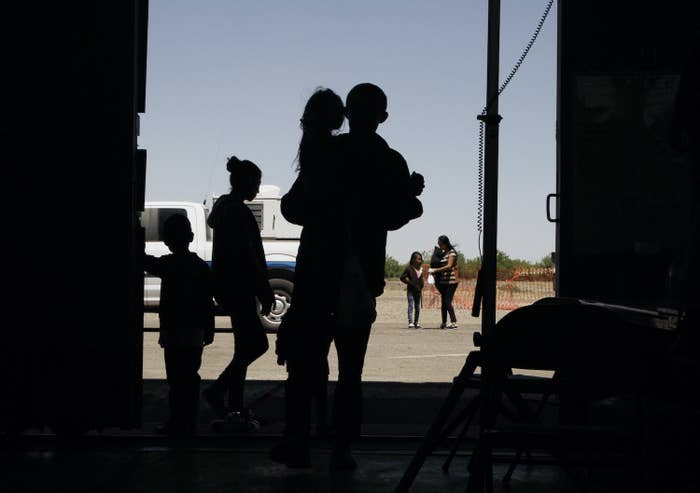The Trump Administration Is Considering Excluding Some Immigrant Children From A Controversial Pandemic Border Policy

Cedar Attanasio / AP
Immigrants mainly from Central America guide their children through the entrance of a World War II-era bomber hanger in Deming, New Mexico, in 2019.
The Trump administration is considering changing a pandemic-related border policy to no longer quickly return unaccompanied immigrant children to four countries that require them to test negative for the coronavirus before entering, according to a draft of the order obtained by BuzzFeed News.
The draft would amend an unprecedented order issued by the Centers for Disease Control and Prevention earlier this year that allows border officials to expel immigrants at the southern border instead of housing them at facilities in the US for immigration proceedings.
Previously, unaccompanied children were sent to government-run shelters as they attempted to pursue their asylum cases.
Administration officials have argued that the policy, which has led to thousands of immigrants being quickly turned around and deported at the border, is necessary to prevent the spread of the coronavirus in the US and has been a key tool for border agents.
The draft amendment, if implemented, would alter the reality on the ground for those who hail from four countries that require negative COVID-19 tests for re-entry, including for adults.
It’s unclear which countries the draft order is referencing. The draft indicates that the changes have already been in place since late August.
“Apparently, the four home countries will accept the return of their citizens expelled under the Order only if their citizens test negative for COVID-19,” the amendment, authored by CDC Director Robert Redfield, states. “So at least for now, covered aliens who must test negative for COVID-19 before ICE can expel them directly to one of the four home countries should not be expelled from the United States by ICE.” Redfield added that the number of people affected by the change is “relatively small.”
Instead of being quickly deported to their home countries, adult immigrants could be processed normally and sent to ICE custody. But the amendment does not appear to explicitly prevent border agents from using the CDC policy to quickly turn the adults from these countries back around into Mexico. Border agents have used the policy more than 140,000 times since March.
In the case of unaccompanied minors from the countries, the process would return back to previous practice and they would go straight to an Office of Refugee Resettlement shelter from ICE custody.
“On first glance, this revised order seems mostly like an attempt to avoid an embarrassing court defeat,” said Aaron Reichlin-Melnick, a policy analyst at the American Immigration Council. “But on closer examination, it’s also notable for the CDC’s endorsement of the White House’s extreme views that public health laws can be used to permit ICE to deny rights to migrant children and rapidly expel them, even when they’ve already tested negative for COVID-19.”
Before the pandemic, unaccompanied children picked up by Border Patrol agents would be sent to the Office of Refugee Resettlement, where they would be housed in shelters as they officially started applying for asylum and waited to be reunited with family members in the US.
But those referrals dropped precipitously after the issuance of the CDC order. Instead, unaccompanied children at the border are turned back and expelled by DHS officials under the coronavirus order. The ORR referral process was created by the Trafficking Victims Protection Reauthorization Act, which was signed by then-president George W. Bush in 2008. Under the law, CBP officials are generally required to refer the children within 72 hours to the US refugee agency.
“It is telling that it is not concern for asylum seekers that drove the administration’s realization that they could safely accept these migrants, but rather their interest in maintaining a stream for deportations,” Sarah Pierce, an analyst at Migration Policy Institute, told BuzzFeed News. “If the administration knows that there are a number of migrants it can safely process, why not move forward with processing at least that number? Why limit it to migrants from these four countries?”

Rebecca Blackwell / AP
Immigrant children walk with their families along the Rio Grande as pedestrian commuters use the Puerta Mexico bridge to enter Brownsville, Texas, seen from Matamoros, Mexico, in 2019.
In recent weeks, however, the number of children being referred to ORR has gone up.
In late June, US District Judge Carl Nichols, who was appointed by President Donald Trump, blocked the removal of a 16-year-old Honduran boy under the CDC order. While the ruling did not void the policy altogether, it was seen as a blow to the administration. Since then, the administration has said it was no longer seeking to use the CDC order to remove him from the country.
The ACLU also filed a class-action lawsuit in federal court seeking to represent children caught up by the order.
On Friday, a federal judge ordered the Trump administration to stop detaining immigrant children in hotels before quickly sending them back to their home countries under the pandemic border policy.
In August, ProPublica reported that the US had agreements with 10 countries to return children under the CDC order requiring a negative COVID-19 test prior to arrival.
The Trump Administration Is Considering Excluding Some Immigrant Children From A Controversial Pandemic Border Policy
![The Trump Administration Is Considering Excluding Some Immigrant Children From A Controversial Pandemic Border Policy]() Reviewed by Your Destination
on
September 08, 2020
Rating:
Reviewed by Your Destination
on
September 08, 2020
Rating:


